Heptagenia sulphurea Muller - Yellow May
Phylum: Arthropoda - Class: Insecta - Order: Ephemeroptera - Family: Heptagenidae
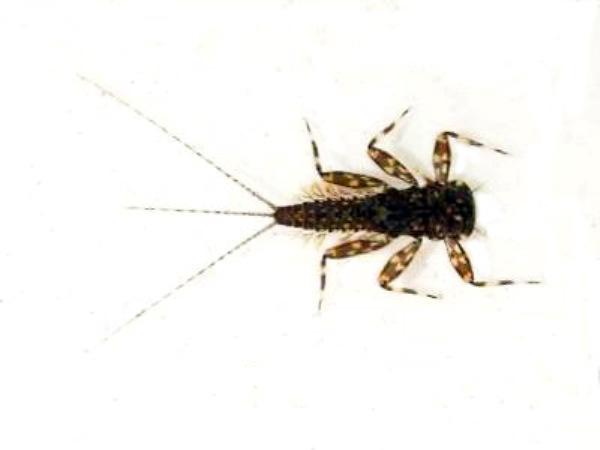
Nymph of the Yellow May, Heptagenia sulphurea
The nymph of the Yellow May is a stone clinger and is far more common on spate rivers than on chalk streams. For example this fly is abundant and widespread on the River Teifi in West Wales, our home river, and on every other Welsh spate river.
These flattened stone-clinger nymphs are distinctively patterned, and the alternating light-and-dark bars of the tails helps separate this species from the otherwise very similar Heptagenia longicauda. The latter is a very rare species in Britain and therefore of no interest to flyfishers; in any case its winged adults are so similar in appearance to those of the Yellow May that a trout would certainly not be able to differentiate between these two species.
Heptagenia nymphs are quite similar to Ecdyonurus nymphs - for example nymphs of the Autumn Dun, Ecdyonurus dispar - but in Ecdyonurus nymphs the pronotum (the plate-like cover of the first segment of the thorax) extends rearwards over part of the next segment, whereas in Heptagenia species it does not..
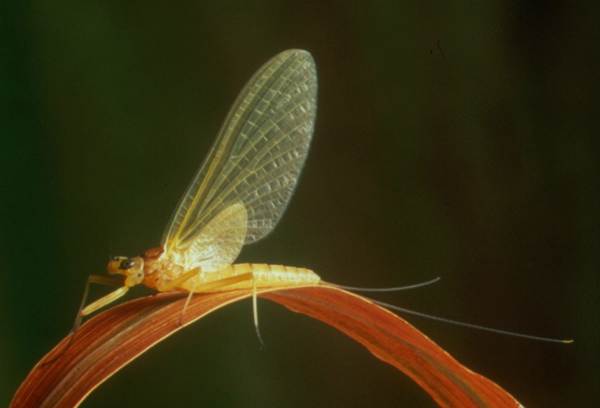
A female dun of the Yellow May
Dun or subimago
The main hatch of Yellow Mays usually begins in the second half of May and continues through June and well into July, with some of these flies trickling off as late as September.
There is concern that the behaviour of this insect may be changing, perhaps due to climate change, as there are reports of fewer Yellow Mays emerging early in the summer and more of them hatching later in the year. The Riverfly Partnership has been gathering data from anglers in order to investigate this matter.
The duns, with their brilliant sulphur yellow wings, hatch in open water from mid morning onwards, and their numbers increase towards dusk. The female is similar to the male, but with smaller eyes.
This is such a beautiful up-winged fly that I chose to use it as the main cover photograph for Matching the Hatch.
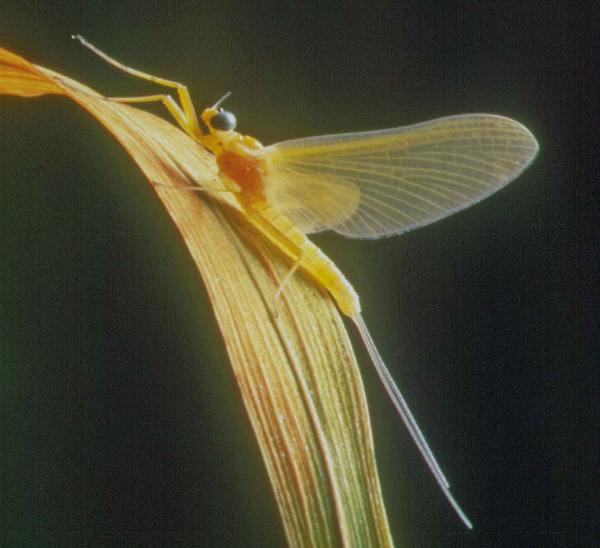
A male dun of the Yellow May. (What big eyes you have got!)
Even after sixty years of flyfishing I still marvel at the brilliance of these insects as they leave the water and head off into nearby trees to await the final phase of their lives as mating spinners.
The main hatches of Yellow May duns come off riffles and fast glides rather than slow-drifting pools, and so fast water is best for fishing when these flies are hatching.
It is a myth, I am convinced, that the trout in England's chalkstreams 'do not like' Yellow May duns, but I have seen that claim stated in writing many times, not only in magazine articles but also in at least one book on the subject of angling entomology. Since trout swallow flies whole, rather than chewing them first, how can their taste be an issue?
It seems to me most likely that when and where these golden nuggets are ignored it is all to do with their relative scarcity on alkaline chalkstreams compared with acid spate rivers.
Trout learn the hard way what is safe to eat, and the flies that they see most often would surely therefore be instantly recognised and seized, while anything unusual ( just like a poor imitation offered in a prolific hatch) is more likely to raise suspicion. All this is surmise, but based on the observation that big trout are not generally bold trout, and vice versa. Colossal trout are cautious and cowardly!
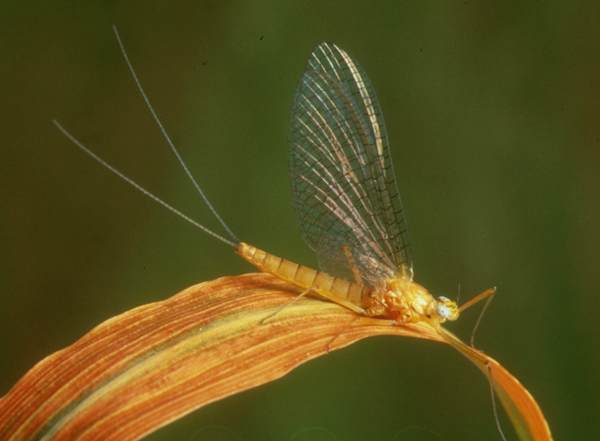
A female spinner of the Yellow May
Spinner or imago
The female spinner of the Yellow May is a most beautiful insects. Its wings are transparent, with black veining, and the body is golden yellow.
On warm evenings from sunset until dusk the female spinners return to the water to lay their eggs. On some spate rivers the result can be a very selective evening rise.
Early in the evening, duns and egg-laying spinners may be on the water at the same time. Fortunately, the same artificial fly serves as an imitation of each of these stages in the life cycle of the Yellow May.
Eventually, after completing her egg laying, the female collapses onto the surface of the water and dies. Then the wings lie flat on the surface rather than standing upright above the body of the fly. This is when I switch to a spent pattern, tied with wings straight out and without hackles beneath the body, so that my artificial fly lies in rather than on the surface.
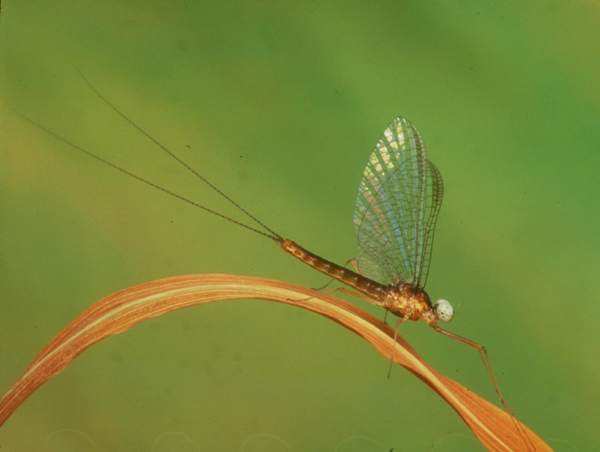
A male spinner of the Yellow May
The male spinners are similar to their mates, but the bodies are rather darker; they less frequently end up on the surface of the water. Instantly recognisable by their large sky-blue eyes, male spinners are of little interest to flyfishers on calm evenings.
On blustery evenings, it is not uncommon to see males blow on to the surface in moderate quantities; however, even then there are usually far more female Yellow May spinners available to trout than there are males. I have never found it necessary in such situations to use anything other than a bright yellow artificial fly, and so the patterns mentioned below are the only ones I carry with me to match the Yellow May hatch.
Matching the Hatch
As the nymphs of the Yellow May live under stones during daylight hours, it is only during a hatch that trout have much of a chance to feed on them. A Gold-ribbed Hare's Ear works fine.
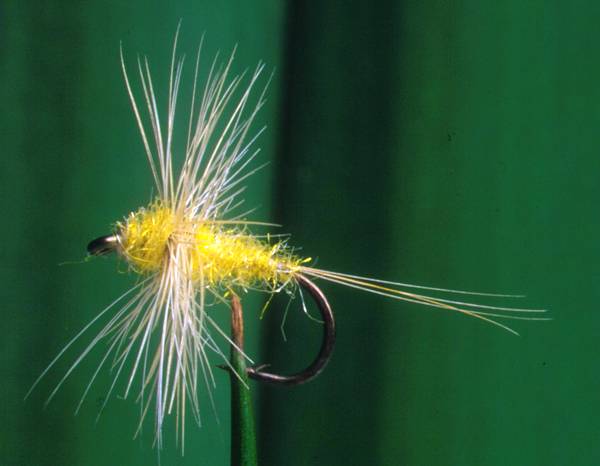
Thorax Hackle Dun, devised by Mike Weaver
Yellow Mays duns and spinners are large flies - quite a lot bigger than a Large Dark Olive but still considerably smaller than a Mayfly. A size 14 standard hook is about right for tying either a nymph or a dry fly, but if you have difficulty seeing small flies on turbulent water don't hesitate to go up to a size 12. (Trout are greedy, and a slightly larger than life Yellow May seems to have added appeal when the water conditions make it difficult for trout to spot a small fly on the surface.)
A pattern that works very well in turbulent water is the Thorax hackle Dun. This general representation of a Yellow May floats high up on the surface of the water, and so it can be used to imitate both the dun stage and the egg-laying spinner stage.
A closer imitation, and one that is particularly good when spent Yellow May spinners are drifting downstream is the Yellow May Sparkle Dun. This, too, is a Mike Weaver pattern.
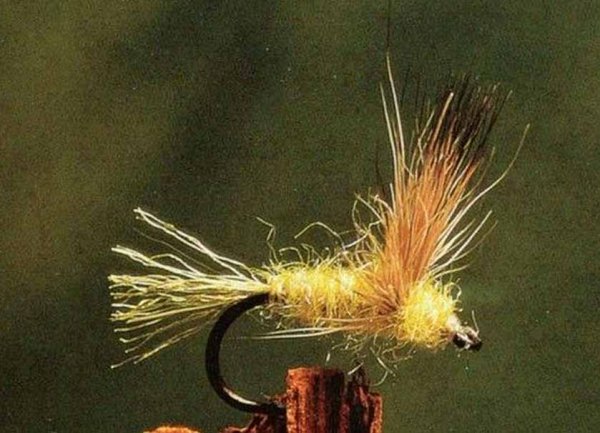
Sparkle Dun, devised by Mike Weaver
Fishing tactics
If your flyfishing takes you to spate rivers in the Westcountry, Wales, Northern England or Scotland in May or June, I strongly recommend that you have in your armoury some flies to match the hatch of Yellow Mays. Where they hatch in good numbers, these large, easy-to-identify up-winged flies can result in a selective rise, as trout become preoccupied with these large, high-visibility morsels and tend to ignore other flies - including yours if it's not a reasonable imitation of the Yellow May.
During a hatch of Yellow May Duns or a fall of their clear-winged spinners, the flies mentioned above are far superior to any general representation 'olive' such as Greenwell's Glory, Rough Olive, Grey Duster etc. The tying details together with fishing tips are covered on pages 73 to 75 of Matching the Hatch.
If you don't have a copy of Matching the Hatch, the pictures above gives you something to aim for when devising your own artificial pattern. The main point is not to copy someone else's artificial fly but to try to achieve something which, seen from under the water (the trout's point of view) looks sufficiently like the real thing not to raise suspicion. The final part of the deception is to control your fly on the water so that it behaves similarly to the natural insect that it is meant to mimic.
Similar Species
Heptagenia longicauda adults are sulphur yellow like those of the Yellow May, and only by close inspection of colour patterns on the legs can the two be separated in the field. This is such a rare fly that for flyfishing purposes it can be ignored; in any case, whatever artificial fly you use to match the Yellow May would be equally appropriate if you were to go fishing somewhere where Heptagenia longicauda hatches in abundance.
Potamanthus luteus, the Yellow Mayfly, is also extremely rare in Britain, having been seen in recent years only on the River Wye. It is a large fly - almost as big as the Mayfly, Ephemera danica - but you will immediately see how it differs from the Yellow May, because as an adult insect it retains three tails (as does the Mayfly, of course). Yellow May duns and spinners each have only two tails.
Excited at the prospect of flyfishing? So are we, and we're pretty sure you would find the Winding River Mystery trilogy of action-packed thrillers gripping reading too. Dead Drift, Dead Cert, and Dead End are Pat O'Reilly's latest river-and-flyfishing based novels, and now they are available in ebook format. Full details on our website here...
Buy each book for just £4.96 on Amazon...
Please Help Us: If you have found this information interesting and useful, please consider helping to keep First Nature online by making a small donation towards the web hosting and internet costs.
Any donations over and above the essential running costs will help support the conservation work of Plantlife, the Rivers Trust and charitable botanic gardens - as do author royalties and publisher proceeds from books by Pat and Sue.
